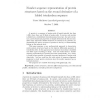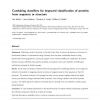151 search results - page 3 / 31 » Classifying protein sequences using hydropathy blocks |
NAR
2000
13 years 7 months ago
2000
The ProtoMap site offers an exhaustive classification of all proteins in the SWISS-PROT database, into groups of related proteins. The classification is based on analysis of all p...
CORR
2006
Springer
13 years 7 months ago
2006
Springer
A protein is a sequence of amino-acids of length typically less than 1, 000, where there are 20 kinds of amino-acids. In nature, each protein is folded into a well-defined three-d...
BMCBI
2002
13 years 7 months ago
2002
Background: Most profile and motif databases strive to classify protein sequences into a broad spectrum of protein families. The next step of such database studies should include ...
BMCBI
2008
13 years 7 months ago
2008
Background: Predicting a protein's structural or functional class from its amino acid sequence or structure is a fundamental problem in computational biology. Recently, there...
EVOW
2004
Springer
13 years 11 months ago
2004
Springer
A number of bioinformatics tools use regular expression (RE) matching to locate protein or DNA sequence motifs that have been discovered by researchers in the laboratory. For exam...


